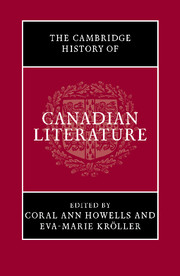Book contents
- Frontmatter
- Introduction
- PART ONE OLD AND NEW WORLD, LA NOUVELLE-FRANCE, THE CANADAS, DOMINION OF CANADA
- PART TWO THE POST-CONFEDERATION PERIOD
- PART THREE MODELS OF MODERNITY, POST-FIRST WORLD WAR
- PART FOUR AESTHETIC EXPERIMENTS, 1960 AND AFTER
- 18 Quartet: Atwood, Gallant, Munro, Shields
- 19 The short story
- 20 Canadian drama: performing communities
- 21 Poetry
- 22 Poetry, drama, and the postmodern novel
- 23 Comic art and bande dessinée: from the funnies to graphic novels
- 24 “Ghost stories”: fictions of history and myth
- 25 Indigenous writing: poetry and prose
- 26 Contemporary Aboriginal theater
- 27 Transcultural life-writing
- 28 Multiculturalism and globalization
- PART FIVE WRITING IN FRENCH
- Bibliography
- Index
- References
18 - Quartet: Atwood, Gallant, Munro, Shields
from PART FOUR - AESTHETIC EXPERIMENTS, 1960 AND AFTER
Published online by Cambridge University Press: 28 September 2010
- Frontmatter
- Introduction
- PART ONE OLD AND NEW WORLD, LA NOUVELLE-FRANCE, THE CANADAS, DOMINION OF CANADA
- PART TWO THE POST-CONFEDERATION PERIOD
- PART THREE MODELS OF MODERNITY, POST-FIRST WORLD WAR
- PART FOUR AESTHETIC EXPERIMENTS, 1960 AND AFTER
- 18 Quartet: Atwood, Gallant, Munro, Shields
- 19 The short story
- 20 Canadian drama: performing communities
- 21 Poetry
- 22 Poetry, drama, and the postmodern novel
- 23 Comic art and bande dessinée: from the funnies to graphic novels
- 24 “Ghost stories”: fictions of history and myth
- 25 Indigenous writing: poetry and prose
- 26 Contemporary Aboriginal theater
- 27 Transcultural life-writing
- 28 Multiculturalism and globalization
- PART FIVE WRITING IN FRENCH
- Bibliography
- Index
- References
Summary
In 1955, when she was about sixteen, Margaret Atwood announced to the other girls she lunched with at Leaside High School in Toronto that she intended to be a writer. Five years before that, Mavis Gallant had quit her job at the Montreal Standard and moved to Paris resolved to do the same thing. “I believed that if I was going to call myself a writer, I should live on writing.” The first story she had submitted to The New Yorker came back, she has also recalled in the Preface to her Selected Stories (1996), “with a friendly letter that said, ‘Do you have anything else you could show us?’” She did, and the second story she sent, “Madeline’s Birthday,” was accepted and appeared in that magazine on September 1, 1951 – it proved to be the first of over a hundred stories she would first publish there. By 1955 too, Alice Munro had appeared with half a dozen stories in such Canadian outlets as the Canadian Forum, Mayfair, and Queen’s Quarterly and had four broadcast on CBC radio, but her second daughter was born that year so mostly her time was spent being a mother and wife in West Vancouver. Her initial appearance in The New Yorker, the first of over fifty stories ultimately, would not happen until 1977. In 1955, Carol Warner was still an undergraduate at Hanover College in Indiana; she would not become Carol Shields until 1957, when she married. She began publishing poetry and criticism in the early 1970s, subsequently establishing herself as a writer.
- Type
- Chapter
- Information
- The Cambridge History of Canadian Literature , pp. 355 - 380Publisher: Cambridge University PressPrint publication year: 2009



